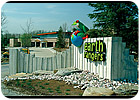
The Earth Rangers Centre in Woodbridge, ON, Canada, was designed with leading-edge environmental technologies, including a radiant heat-ing/cooling system that will enable it to use approximately 63% less energy than the standard dictated by the Model National Energy Code of Canada for Buildings.
The Earth Rangers Centre in Woodbridge, ON, Canada, functions as a wildlife refuge and hospital and as an education center for children. The 60,000-sq-ft facility, which opened in October 2004, houses a world-class veterinarian research and training hospital, interactive educational displays for the public, and will soon include one of Canada's only oil spill response units dedicated to wildlife.
The building was designed with leading-edge environmental technologies, which in conjunction with forward-thinking design and engineering, will enable it to use approximately 63% less energy than the Canadian standard dictated by the Model National Energy Code of Canada for Buildings (MNECB). To qualify for public funding as a "green" building, the center had a number of criteria to meet, including low energy use, water conservation and reuse, enhanced indoor environmental conditions, materials with high recycled content and low embodied energy, and minimal environmental impact on the site.
Other unique design elements were necessary to accommodate the building's unusual full-time occupants such as beavers, deer, raptors, and songbirds, to name a few. Treatment and rehabilitation rooms for these special residents also demanded durability, water-resistance, and as few hiding and escape nooks as possible. As a health care facility, good ventilation and comfortable living conditions for the ailing animals were also a priority. To meet these demands, the project's engineers specified hydronic radiant heating and cooling.
REMOVING CRITTER CRAWLSPACES
The Earth Rangers Centre is one of the first buildings in North America with 100% reliance on radiant heating and cooling. A REHAU system was selected in part because it eliminates ductwork in which animals can hide, and it uses a concrete floor surface that's easy to clean and maintain.Additionally, Mark Euteneier, installer and president of Klimatrol Environmental Systems, said that the system complements the building's energy-conserving structure - reinforced concrete with load-bearing masonry walls in the animal areas. The interior concrete walls and masonry are able to function as thermal storage, improving the building's comfort and energy performance.
The system employed 74,000 ft of REHAU's RAUPEX® 02 Barrier which was installed in more than 36,000 sq ft of exposed concrete slabs at 6-in. and 12-in. spacing. RAUPEX was installed in both the floor and ceiling - as well as in the cast-in-place skylights - in order to collect, distribute, and maximize solar gain. A high efficiency Viessmann Vertomat 1 MBtu output hot water boiler was specified as the heat source.
HAPPINESS IS ... A WARM SLAB
The combined ceiling and floor slab mounted design enables the system to provide both efficient heating and cooling. The system's cooling function employs concrete slabs that are actively cooled to approximately 64°F overnight using circulating water from a cooling tower. The slabs warm up slightly during the day as they absorb heat from the space. A low-energy-consuming evaporative cooling tower provides most of the energy, supplemented by a small electric chiller. In all, the cooling load for ventilation and space conditioning is only 64 tons - less than half that of a comparably sized conventional building.The heating function provides additional efficiency. "Typically for a low-energy building, if a slab has adequate capacity for cooling, it will have more than enough capacity for heating," explained Richard Lay senior design engineer at Enermodal Engineering Ltd., and engineer of record for the Earth Rangers project.
Radiant ceiling heating also creates a uniformly comfortable environment for the animals, without the drafts, dust, and noise sometimes associated with forced-air systems. Because the building also serves as a health care facility, it required 100% outdoor air ventilation with no interior recirculation. To meet this demand, as well as enhance the building's energy efficiency, the ventilation system was designed using a total of nine 66-ft-long concrete "earth tubes" buried below the frost line. These tubes pre-temper the air prior to entering the building's AHU by an average of 5° in winter and summer, further complementing the radiant system's efficiencies.
The ventilation system was designed to reduce heating and cooling load energy requirements by 30 kW. This reduction provides a 12% increase in ventilation heat recovery effectiveness, and an estimated $7,000 per year operating cost reduction.
In all, the Earth Rangers ventilation system is believed to be the largest ground heat exchange system of its type in a North American building. "We are certainly enthusiastic about people seeing what the center does to help animals, as well as how it has been designed with energy efficiency as a top priority," said Lay.ES
